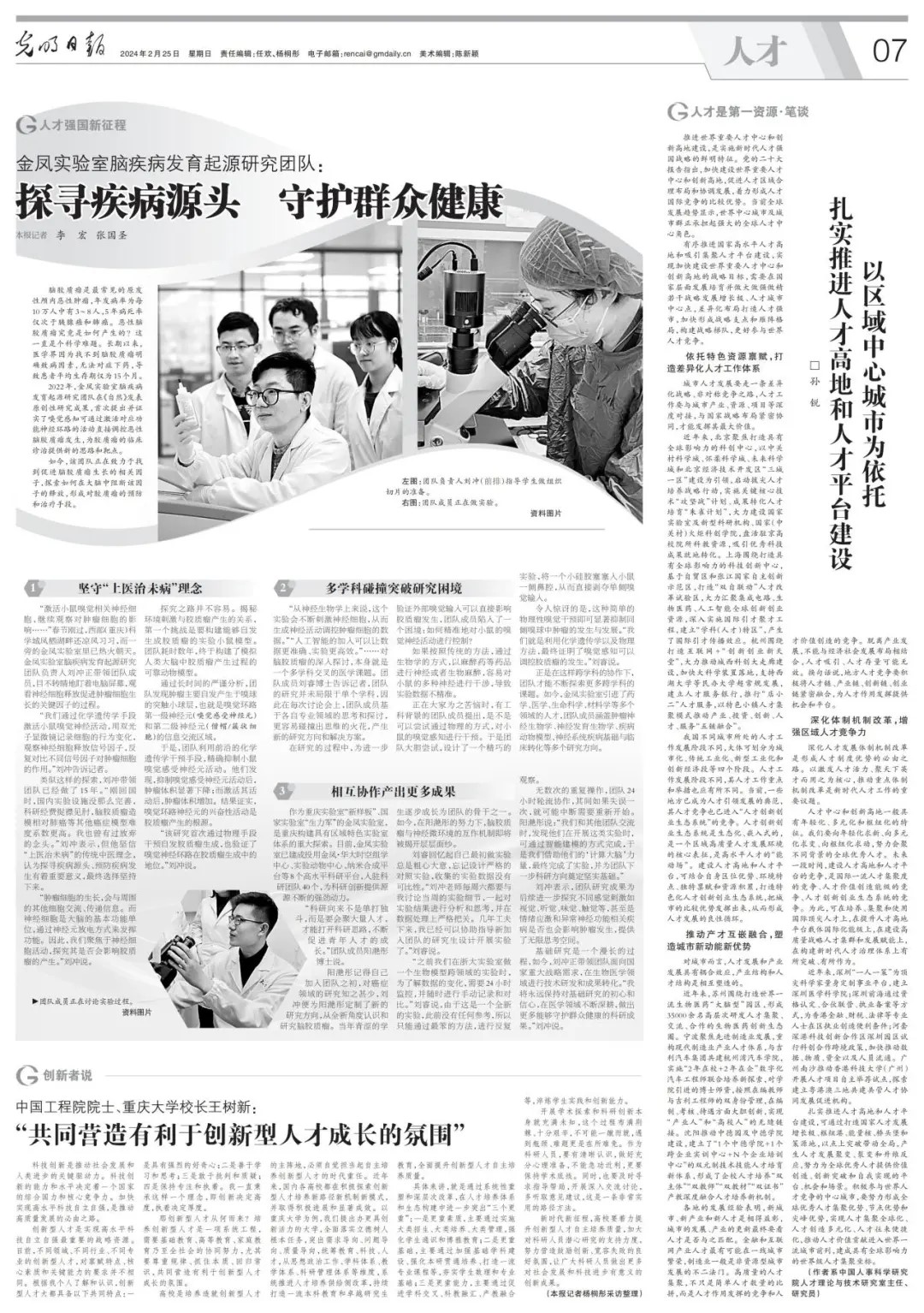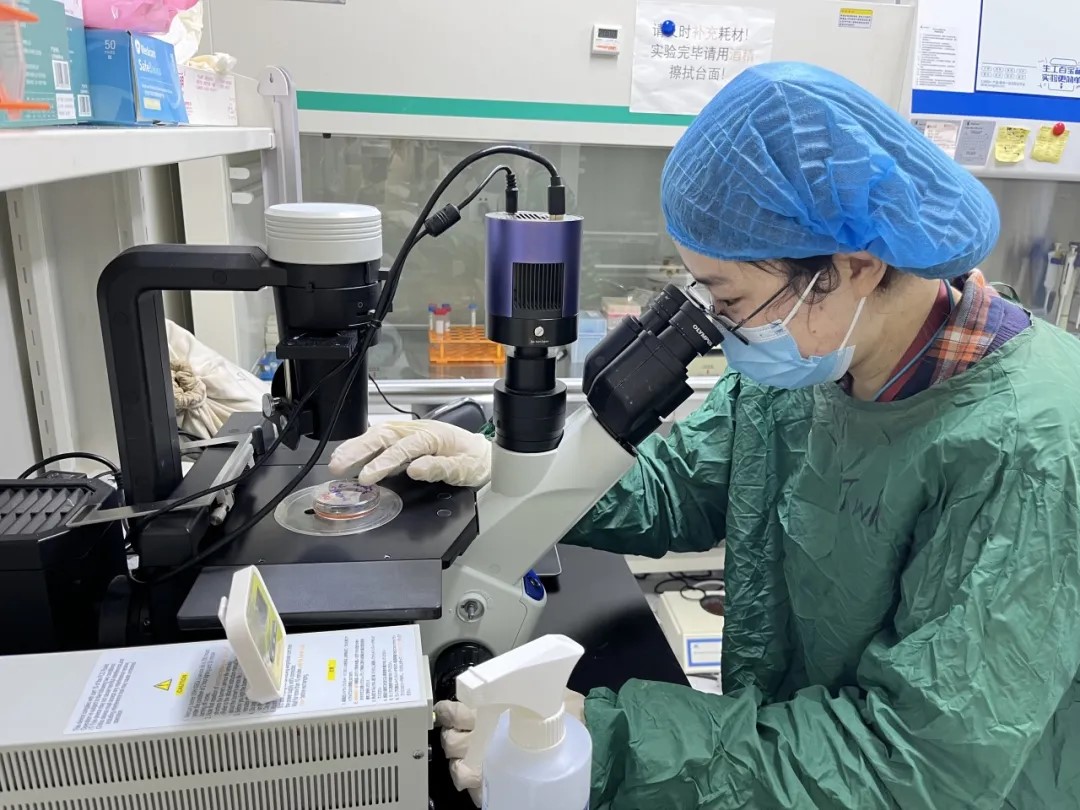
"guangming daily" reported | jinfeng laboratory's research team on the developmental origins of brain diseases: exploring the source of diseases to protect people's health
general secretary xi jinping pointed out that if our country wants to be at the forefront of the world in scientific and technological innovation, it must discover talents in innovative practices, cultivate talents in innovative activities, and gather talents in innovative undertakings. it must vigorously cultivate and create large-scale, reasonable structures, and high-quality talents. of innovative scientific and technological talents. we must put the development of human resources as the highest priority in scientific and technological innovation, reform the mechanisms for talent training, introduction, and use, strive to create a group of world-class scientists, scientific and technological leaders, engineers, and high-level innovation teams, and focus on cultivating front-line innovative talents and young scientific and technological talents.
jinfeng laboratory has always adhered to the concept of "talent is the first resource", introduced talents based on targeted tasks, allocated functional resources in a matrix model, carried out organized scientific research, and organized interdisciplinary, cross-regional, and scientific research based on the scientific research task list. cross-field scientific and technological talents conduct "large-scale" operations and integrated research, focusing on accelerating original theoretical innovation in the field of precise diagnosis and breakthroughs in basic theoretical breakthroughs in "stuck-neck" technologies.
currently, the laboratory has a total of 40 scientific research teams and 401 scientific researchers, including 5 academician teams and 33 national-level talents.
"guangming daily"
NEWS
on february 25, the talent section of "guangming daily" reported a full-page report on "jinfeng laboratory's developmental origin of brain disease research team: exploring the source of disease to protect people's health", which demonstrated that jinfeng laboratory adheres to scientific and technological innovation and institutional innovation to strengthen the effectiveness of basic research talent team building.

the original text is as follows
jinfeng laboratory’s research team on the developmental origins of brain diseases:
explore the source of disease and protect people’s health
a new journey to strengthen the country through talents
in 2022, the jinfeng laboratory's research team on the developmental origins of brain diseases published original research results in nature, proposing and confirming for the first time that olfactory perception can directly regulate the occurrence of malignant gliomas by activating the activity of corresponding functional neural circuits. provide new ideas and targets for the clinical diagnosis and treatment of glioma. now, the team is working to find the relevant factors that promote the growth of brain glioma, and explore how to block the release of this factor in the brain to form prevention and treatment methods for glioma.

team leader liu chong (front row) guides students in preparing tissue sections.
adhere to the concept of "preventing disease with superior medicine"
"we activated the olfactory nerve activity of mice through chemical genetic means, recorded the behavioral changes of cells with a two-photon microscope, observed the release of signaling factors by nerve cells, and repeatedly compared the effects of different signaling factors on tumor cells." liu chong told reporters. liu chong has led the team to conduct explorations like this for 15 years. "when i first returned to china, domestic experimental facilities were not so complete and scientific research funds were scarce. modeling brain glioma was more difficult than lung cancer and other cancer models. i also had the idea of giving up." liu chong said, but he firmly believed the traditional chinese medicine concept of "preventing disease with superior medicine" believes that it is of great significance to explore the source of disease and prevent the occurrence of disease, and finally chose to stick to it. "the growth of tumor cells will communicate and transmit information with other surrounding cells. nerve cells are the basic functional units of the brain and function through the way neurons discharge. therefore, we focus on nerve cell activity to explore whether it will affect the occurrence of glioma," liu chong said. the path of inquiry is not easy. to unravel the relationship between environmental stimuli and the development of glioma, the first challenge is to construct an experimental mouse model that can spontaneously develop glioma. the team spent several years building a reliable animal model that simulates the development of glioma in the human brain. through a long period of rigorous analysis, the team found that tumors mainly arise spontaneously in the synaptic glomerular layer of the olfactory bulb, which is the first-level neurons (olfactory receptor neurons) and second-level neurons (mitral/tufted) of the olfactory circuit. cells) information exchange area. therefore, the team used cutting-edge chemical genetic intervention methods to precisely inhibit the activity of olfactory receptor neurons in mice. they found that suppressing the activity of olfactory receptor neurons significantly reduced tumor volume, while activating their activity increased tumor volume. the results confirmed that the excitatory activity of olfactory circuit neurons is the root cause of glioma. "this study is the first to intervene in spontaneous glioma formation through physical means, and also verifies the role of the olfactory nerve circuit in glioma formation," liu chong said.

team members are conducting experiments.
multidisciplinary collision breaks through research dilemmas
during the research process, in order to further verify that external olfactory input can directly affect the occurrence of glioma, team members fell into a dilemma: how to accurately control the olfactory nerve activity of mice? if we follow the traditional method of using anesthetics and other drugs for neurological or biological anesthesia through biological means, it will easily interfere with various nerves in mice, resulting in inaccurate experimental data. while everyone was worrying about it, team members with engineering backgrounds asked whether they could try to intervene in the mice's olfactory perception through physical means. so the team made a bold attempt and designed an ingenious experiment, inserting a small silicone plug into one side of the mouse's nasal cavity to directly deprive unilateral olfactory input. surprisingly, this simple physical olfactory intervention can significantly inhibit the occurrence and development of tumors in the ipsilateral olfactory bulb. "we used chemical genetics and physical methods to finally prove that olfactory perception can regulate the occurrence of glioma." liu rui said. it is with this kind of interdisciplinary collaboration that the team can continue to explore more interdisciplinary topics. today, jinfeng laboratory has introduced talents from many fields such as pharmacy, medicine, life sciences, and materials science. the team members cover tumor neurobiology, neurodevelopmental biology, disease animal models, neurological disease basics and clinical translation, etc. a research direction.
collaborate to produce more results
"scientific research has never been done alone, but by gathering a large number of talents to open up scientific research ideas and continuously promote the growth of young talents." said team member dr. yang yantong. yang yantong remembered that when he first joined the team, he knew little about cancer research, so liu chong customized a new research direction for yang yantong to understand and study brain glioma from a new perspective. the young student gradually grew into one of the backbone of the team. now, with the efforts of yang yantong, the interaction mechanism between brain glioma and the neural microenvironment is about to be unveiled. liu rui recalled that he was always careless in his initial experiments, forgetting to design strict controlled experiments, and the experimental data collected were not comparable. "teacher liu chong discusses the details of the week's experiments with me every saturday, analyzes and thinks about the experimental results together, and strictly controls the data processing. over the past few years, i have been able to help guide new graduate students who have joined the team design and conduct experiments," liu rui said. "previously, when we were doing a cross-field experiment on a biological model in the zhejiang university laboratory, in order to understand the changes in the data, we needed 24-hour monitoring and manual recording and comparison at any time." liu rui said that since this is a brand-new experiment, previously there is no reference, so we can only make repeated observations through the stupidest method. countless repeated operations, the team takes turns to collaborate 24 hours a day. if a mistake is made during this period, it may be interrupted and need to be started again. yang yantong said: "when we communicated with other teams, we found that when they carried out such experiments, they could complete it through intelligent modeling, so we used their 'computing brain' power to finally complete the experiment and provide the team with liu chong said that the team's research results will further explore whether different sensory stimuli such as vision, hearing, taste, touch, etc., and even emotional stress and abnormal neurological function-related diseases can also affect tumorigenesis. , providing unlimited space for thinking. basic research is a long process. today, liu chong is leading the team to carry out technology research and development and achievement transformation in the field of biomedicine in response to major national strategic needs. "i will always maintain my original intention and confidence in basic research, continue to deepen my work in the medical field, and make more scientific research results that can protect the health of the people." liu chong said.
- About Us
-
Research Platform
- Major Disease Sample Database
- Innovative Drug Verification And Transformation Platform
- Experimental Animal Center
- Life And Health Future Laboratory
- Biomedical Imaging Platform
- Cell Multi-Omics Platform
- Pathology Technology Platform
- Bioinformatics Research And Application Center
- Jinfeng Pathology Precision Diagnosis Center
- Research Team
- Information Center
- Join Us


 渝公网安备50009802002274
渝公网安备50009802002274